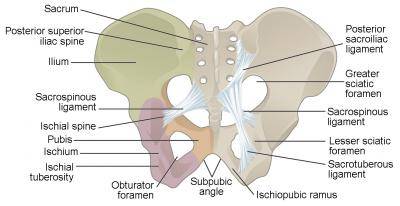I and IV only
ll and lll only
l and ll only
l, ll and, lll only
Correct answer is C
III & IV are considered invalid because some desert animals are poikilotherm.
Poikilotherm or cold blooded animals are the animals (without sweat pores) whose body temperature vary with the temperature of the environment.
e.g Amphibians and reptiles are poikilothermic animals.
The two halves of the pelvic girdle are joined together at the?
pubic symphysis
ilium
pubis
obturator foramen
Correct answer is A

The pubic symphysis is found on the anterior side of the pelvis and is the anterior boundary of the perineum. The pubic bones form a cartilaginous joint in the median plane, the symphysis pubis. The joint keeps the two bones of the pelvis together and steady during activity.
Which of the following organisms is mainly found in the marine habitat?
Achatina
Tilapia
Dog fish
Tortoise
Correct answer is C
Dogfish are types of sharks that are common tropical open sea fishes, with others like mackerel, sea catfish, etc.
The blood component that has the greatest affinity for oxygen is the
lymphocytes
leucocytes
erythrocytes
thrombocytes
Correct answer is C
No explanation has been provided for this answer.
The barrier between maternal and fetal blood is the?
placenta
liver
umbilical cord
uterine wall
Correct answer is A
No explanation has been provided for this answer.
JAMB Subjects
Aptitude Tests